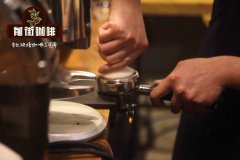What is the roasting curve of coffee beans? which is the better roasting degree of Kenyan coffee?

Professional coffee knowledge exchange more coffee bean information please follow the coffee workshop (Wechat official account cafe_style)
Front Street Coffee Baking Curve and Kenya Coffee Baking Curve sharing
The vertical axis represents the temperature, the horizontal axis represents the time, and the middle part represents the line that the temperature of the raw bean changes with time during the baking process. The value of the circle point is the current boiler temperature, and the raw bean temperature is lower than the preset boiler temperature, so when entering the bean, the temperature curve must have a relative range of slippage. When the internal and external temperature of the coffee bean begins to balance, the curve begins to go up, which is called the "temperature recovery point".
When the temperature rises, the curve slowly climbs up, and the fiber inside the coffee bean begins to change, the cells of the coffee bean are destroyed, and the crackling sound begins to be heard. This is the "explosion".
The time to leave the pot is determined by the baker. after getting out of the pot, start to test the flavor of roasted coffee beans, and then adjust the baking according to the cup test. this is also a way to test where your baking skills go.
[Qilin Yajia (Kirinyaga) producing area]
Roaster Yangjia 800N (baking capacity 500g)
The furnace temperature reaches 170℃ into the pot, the throttle opens 3, the firepower is 100,140 ℃, the air door opens to 3.5; when the furnace temperature is 143.3 ℃, the bean watch turns yellow, the grass smell disappears completely, and enters the dehydration stage.
The smell of toasted bread has obviously changed to the smell of coffee, which can be defined as a prelude to an explosion. At this time, it is necessary to listen clearly to the sound of the explosion point, to the sound of the explosion point, adjust the firepower to 50, adjust the throttle to 4 (the firepower should be very careful, and not be so small as to be free of bursting sound), and develop a burst point after the development of 1 cup 39 blown 50 ", 192 degrees out of the oven.
[Kirin Yajia (Kirinyaga) producing area] Flavor:
Lemon, flower, tomato, citrus, sugar, raspberry, herb, cream, the overall taste is relatively refreshing.
END
Important Notice :
前街咖啡 FrontStreet Coffee has moved to new addredd:
FrontStreet Coffee Address: 315,Donghua East Road,GuangZhou
Tel:020 38364473
- Prev

Mozart coffee bean flavor hand-made Mozart coffee musician series coffee Mozart
Professional coffee knowledge exchange more coffee bean information please follow the coffee workshop (Wechat official account cafe_style) Costa Rica can appreciate Mozart 1900 meters Costa Rica country: Origin: Tarrazu height: 1900 meters processing: raisins Honey processing results: SHB species: Caturra taste description: blackberries, plums, oranges, raisins, raisins, toffee sugar, Karen
- Next

Nicaraguan coffee bean flavor Nicaraguan coffee bean flavor
Professional coffee knowledge exchange more coffee bean information please follow the coffee workshop (Wechat official account cafe_style) Let's start with some terms: when it comes to wine you indulge a little bit of wine tasting. But for a steaming cup of coffee, this process is called cup testing, which is used by professional tasters to evaluate the smell, taste and appearance of coffee beans and coffee samples.
Related
- Beginners will see the "Coffee pull flower" guide!
- What is the difference between ice blog purified milk and ordinary milk coffee?
- Why is the Philippines the largest producer of crops in Liberia?
- For coffee extraction, should the fine powder be retained?
- How does extracted espresso fill pressed powder? How much strength does it take to press the powder?
- How to make jasmine cold extract coffee? Is the jasmine + latte good?
- Will this little toy really make the coffee taste better? How does Lily Drip affect coffee extraction?
- Will the action of slapping the filter cup also affect coffee extraction?
- What's the difference between powder-to-water ratio and powder-to-liquid ratio?
- What is the Ethiopian local species? What does it have to do with Heirloom native species?

